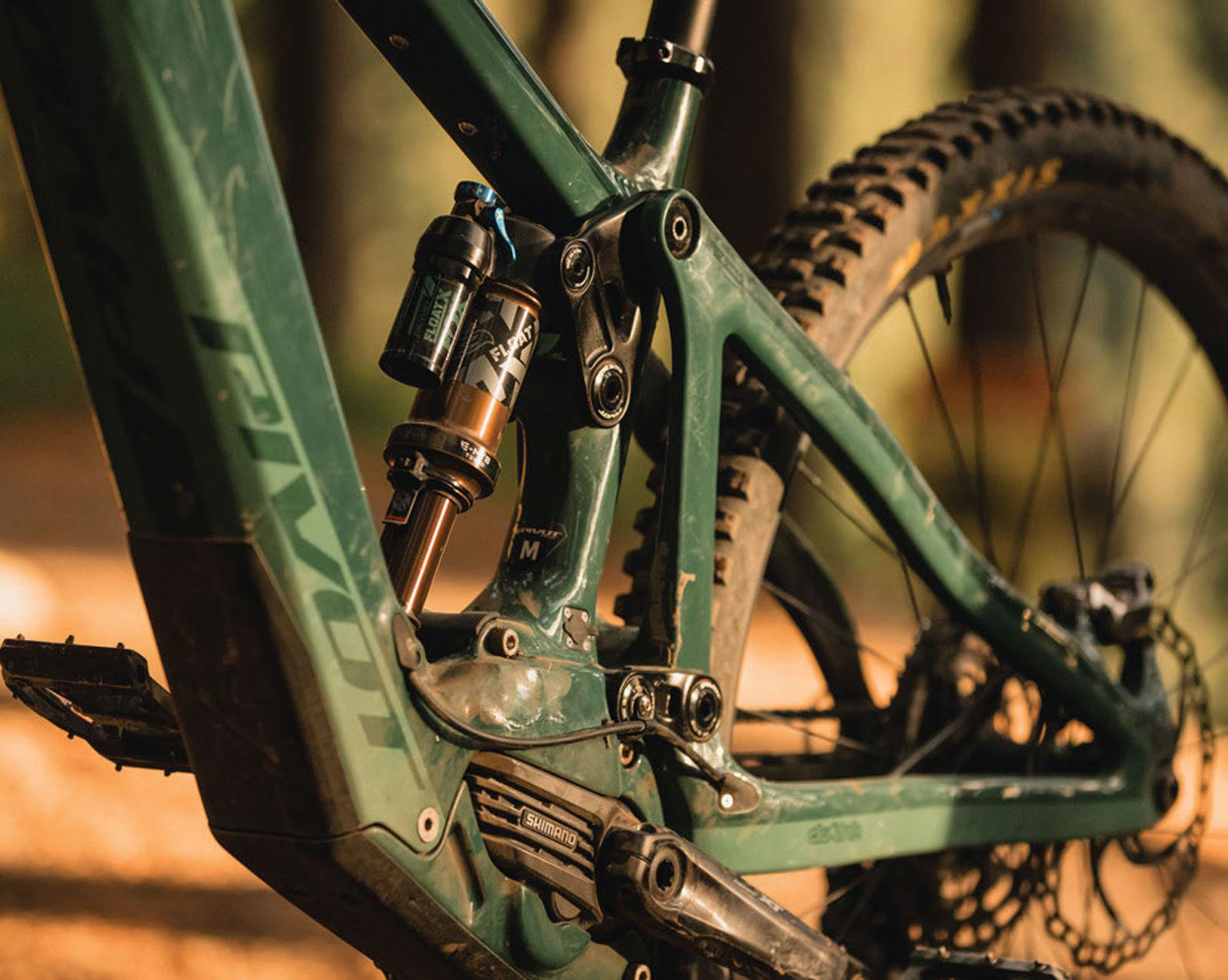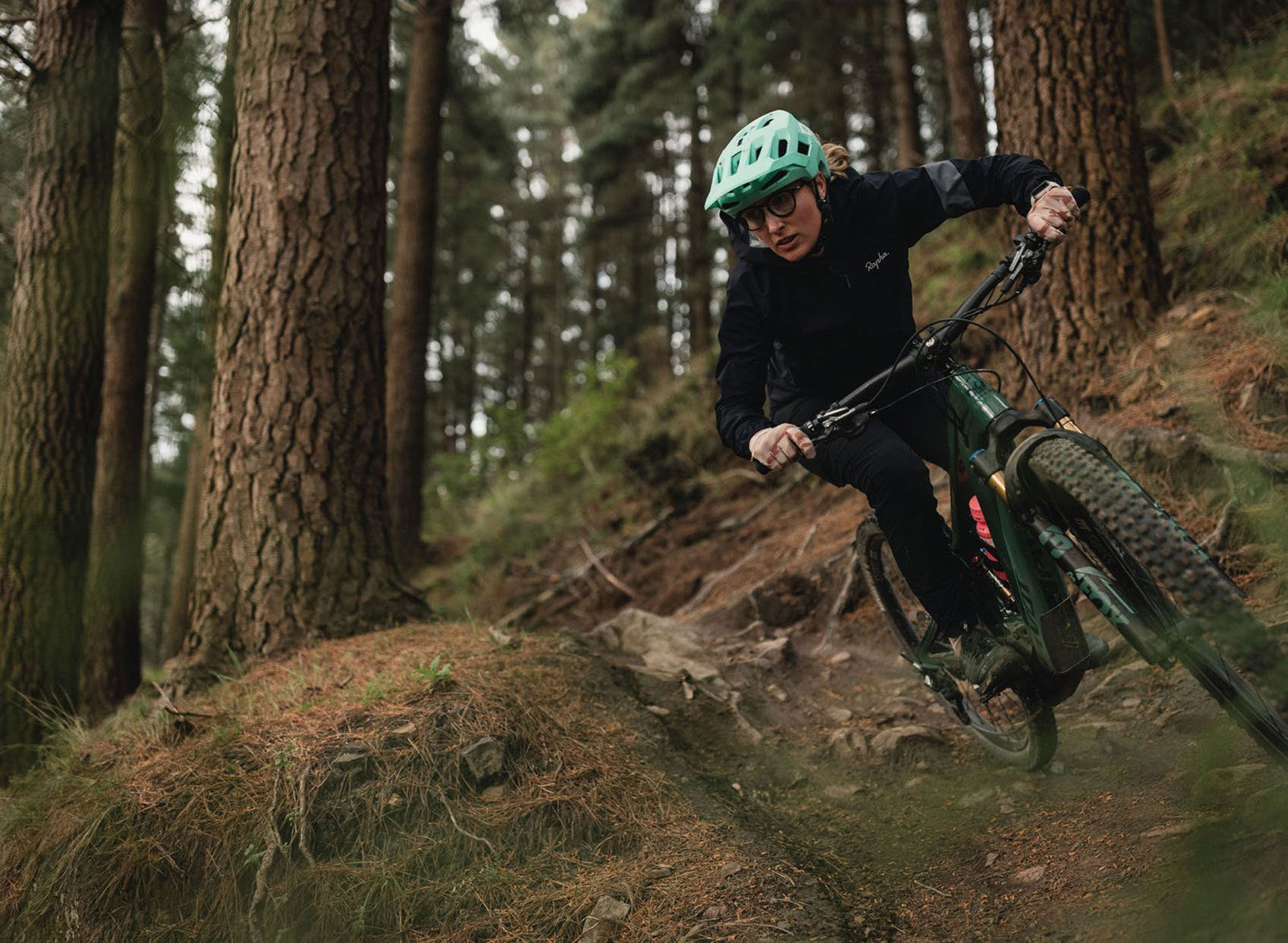Words Georgia Petrie
Images Cameron Mackenzie
RRP $25,995
Distributor Allsports
It’s been several years since we saw Pivot’s first iteration of an eBike. Back then, it was a 27’5” wheel-equipped, 66-degree head-tubed, monstrosity with less power than your toothbrush. Fast forward five years and, thankfully, Pivot’s designs have moved on, along with a lot of the tech hanging between the wheels.
For the eagle-eyed bike nerds amongst us, it was clear to see Pivot’s new design direction from a mile away. It was only a matter of time before we saw them electrify their proven Firebird platform, among others. Those dreams have been realised with the release of the Shuttle LT. Positioned firmly at the top end of their line-up, both in geometry and price, the Shuttle LT isn’t for café enthusiasts.
Frame & Features
Boasting 170mm front and 160mm rear travel, Pivot’s Shuttle LT doesn’t muck around. Paired with aggressive geometry, the bike is a capable all-rounder designed to tackle any trail –the chunkier the better –without compromising on uphill performance. The Shuttle LT comes equipped with Pivot’s long-time, proven, DW-Link suspension platform and atypically short signature Pivot chainstays. That is to say, it’s a nimble climber that, despite its meaty travel, isn’t intimidated by awkward roots and rocks amidst steep ascending pitches. Likewise, on the descents, The DW-Link platform provides superb bump sensitivity, and aids in feeling as if the bike desperately wants you to go faster. This is evident with the Shuttle LT’s non-powered brother, the Firebird, however the added weight of the motor and battery exacerbate its ability to suck up small bumps and heavy hits even further. Like what we’re accustomed to seeing on many other Pivot models, no small details have been missed. It’s clear that a lot of thought has been given to the integration of the eBike specific details on the shuttle, like the power button, charge ports, and custom motor cover/bash plate.

eBike features
The Shuttle LT sports Shimano’s top-tier EP8 system, which boasts 85 NM of torque and a peak power output of 500wh. On trail, the EP8 system performs flawlessly –providing responsive and assertive assistance, whilst not avoiding the high-pitched whirring of generations gone-by. You’d be very hard pressed to find a technical climb that this bike can’t handle – in fact, you’ll find yourself wanting to turn the assistance down, as opposed to up. A key feature of the EP8 system is the connectivity with Shimano’s E-Tube app, which was faultless to connect with and intuitive to use. After a few rides, I found myself wanting to adjust the motor’s tune so that there was more discernible difference between the three modes –Eco, Trail and Boost. I personally found the factory tune to be a little too powerful for my liking, and the difference between Trail and Boost a little too marginal, so I opted instead for a tune with equal difference across the three modes. Out of the box, the Eco tune was akin to riding a magic carpet on climbs – almost a little unnatural, and removing too much of the likeness to a non- powered bike. The difference between Trail and Boost was so marginal that it didn’t really matter which mode you chose, each would fly. Using the app to adjust the assistance offered in each mode improved the riding experience juristically, and helped remove that all-or-nothing feeling -though I’m not sure how many of the prospective buyers for this bike would be aware of that functionality. While the EP8 motor integrates into the frame well, the rest of the system leaves little to be desired. A lot of other manufacturers, such as Brose or Bosch, offer much cleaner and sleeker integration of their displays and controls nowadays, with some handlebar controllers even being wireless, and displays fitted into or onto the top tubes of bikes. In the case of Shimano’s EP8 System, the controls are connected via a network of small cables, linked to a basic display fitted to the handlebar. The system isn’t bad overall, and Shimano’s controller is sleek, but the little cables added have a big impact on the tidiness of the front end.
Geometry
The Shuttle LT sports progressive and aggressive geometry, comparable to many non-powered EDR World Cup winning Enduro bikes. The 64.5-degree headtube angle means the bike isn’t intimidated by steep, technical tails and maintains a “point and shoot” feeling –no matter how tricky the trail, you can be rest assured this bike has got your back. Paired with a long 1245mm wheelbase, the bike excels on fast, wide-open trails where it is stable and planted; however, its heavy weight can sometimes feel a little cumbersome on more awkward, tighter sections of trail, both climbing and descending. The Shuttle LT’s aggressive design continues through into the front triangle, with the bike boasting a longer-than-usual reach – 471mm on the size medium. It’s not uncommon to find many other long-travel eBikes offering smaller reach numbers, as a way to overcome the weight and manoeuvrability penalties of full-powered bikes. In the case of the Shuttle, this long front-centre doesn’t penalize the performance off the bike – rather adding to its point-and-shoot portfolio – but is a critical pinch point for the bike, and prospective buyers whom may be wanting the bike to fit or feel a certain way on the trail. The long reach and wheelbase are complemented by a steep seat tube angle of 77-degrees that balances out the cockpit, creating a forward-riding position that reduces the feeling of reaching far, making the bike delightfully comfortable on lengthy climbs. While the short seat tube ensures the bike is well and truly out of the way when attacking technical descents, those with longer limbs (myself included) may find the stock 175mm Fox Factory Transfer dropper post a little short, leaving more seat post exposed than desired, and therefore find themselves wishing for a 200mm drop post instead.




Ride performance
Climbing
Pivot have managed to strike a fine balance between a wheelbase that creates a stable, planted feel on the descents whilst maintaining a cockpit that doesn’t feel cramped when climbing. Without contradicting myself, the only downside to the Shuttle’s long-limbs is that the bike can be a little cumbersome on tight uphill corners, especially when combined with the added weight of the powertrain. I found myself needing to be a bit careful where you point your front wheel to ensure that the power and torque are tracking exactly where you want to be, because if you end up a little off-line, it can be a bit awkward to correct your trajectory. However, all in all it is delightfully comfortable on the ascents; the upright, forward-climbing position makes it feel almost eager to propel you forward with each pedal stroke, even on the steepest of climbs. This will come as no surprise for those familiar with Pivot’s adaptation of the long-proven DW Link suspension platform – having ridden many of their non-electric offerings in the past, the sensation of efficient propulsion is certainly as present on the Shuttle LT. The shifting quality is impeccable thanks to the top-of-the-line Shimano XTR groupset, meaning you need not worry about the bike hesitating or searching for gears upon downshifting, a particularly beneficial quality given the ample
torque produced by the EP8 motor when climbing.
Descending
Let’s not beat around the bush – with 170mm of travel and aggressive geometry, the Shuttle LT is a bruiser that excels on chunky, high-speed and technical terrain. The bike tackles chundery terrain with ease, and small bump sensitivity is superb with the Fox Factory E-MTB 38 and Float X being the perfect pairing to its aggressive geometry. Compared to the non-electric offerings in Pivot’s range that I’ve ridden previously, such as the Firebird and Switchblade, the Shuttle LT frame feels a little less stiff on high-speed descents which was actually a welcome surprise, as it off-set the added weight of the motor and gave the bike a more natural feel. In classic Pivot fashion, the Shuttle LT sports short chainstays and a low standover, making it easily manoeuvrable in awkward, tight spots and making the rider feel “in control”, which is particularly important to note on an eBike, as the added weight of the motor can often bring about a “lead weight” sensation akin to the bike doing all the work for you. Add to this the Shuttle LT’s slack head angle, which creates a confidence-inducing “point and shoot” feel on particularly steep descents, elevated further when combined with the bike’s ample braking traction. After riding a range of both lightweight and full-powered eBikes, I have often found that brakes are one of, if not THE, most under-gunned components spec’d on these bikes relative to their weight and required stopping power. So, it’s fair to say the Shuttle LT’s XTR brakes, paired with meaty 203mm rotors, were a welcome addition particularly given the steep, technical terrain the bike excels on. However, I would’ve preferred a hardier tyre than the stock EXO+ Maxxis Assegai on the rear, as this had a tendency to lose grip in loose conditions and roll around unnecessarily, so I ended up swapping this out for a Maxxis Minion DHRII with a Double Down Casing to achieve a little more support under braking. Pivot’s contact points also leave a lot to be desired –from the thin, slippy grips to the low-rise bars topped off with the harsh, uncomfortable saddle. Arguably, contact points and tyre choice are subjective, but when paying $25k you’d hope that some of these finer details would be a little more considered. Whilst the Shuttle LT’s big 756Wh battery does provide ample fuel for all-day adventures, because this sits within a relatively chunky downtube coupled with the angled vertical shock mounting position, It does mean you are left with limited additional frame space for other adventure essentials. On the size medium frame I was reviewing, it was a push to fit my smallest 600ml bottle, and trying to strap anything extra to the frame – such as a small jacket or even an enduro banana – is out of the question. Whilst not a dealbreaker, it does mean you need to be extra conscious before heading out the door that you’ve got enough alternative means of carrying your knick-knacks, and more than an hour’s worth of water. These may sound like minor points, but the irony of all this is that with the beefy battery the Shuttle LT boasts, you’re able to extend your rides, albeit without the ability to carry to essentials one may need to support such missions.

Summary
Whilst the Shuttle LT belongs in the upper-ranks of eBike offerings for its well-rounded capabilities and genre-bending descending characteristics, the little details do impact the bike’s scorecard. If you can look past the angled shock position – yes, I said it – then the Shuttle LT is a strong offering in an increasingly completive segment of the e-market. Whilst there are a lot of small details that have been overlooked – from poor spec choices in the tyres and contact points, to the messy cockpit thanks to Shimano’s reliance on cables – the bones of the bike are solid. A good mechanic – or a 6-pack of beers and a few metres of heat-shrink can overcome the clutter, and things like tyres and grips can be swapped. I’ll let you decide if, for $25,995, you should be having to but, firstly, try one on for size as you may find you’ll want to size down.





